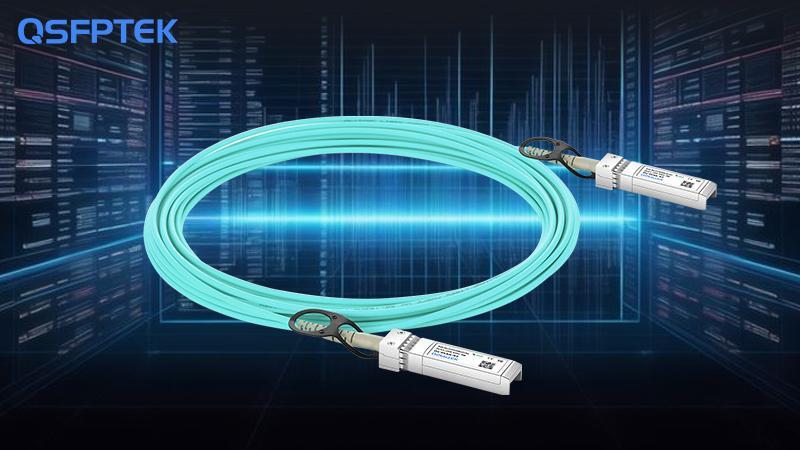The Role of 10G AOC in High-Density Data Centers
In today’s fast-evolving digital world, data centers are required to support ever-increasing data volumes while maintaining high performance and efficiency. As companies transition to more advanced infrastructure, the need for better networking solutions becomes even more critical. One such solution is 10G AOC (Active Optical Cable), a technology that’s gaining traction for its ability to optimize both space and performance in high-density data center environments. In this article, we will explore how 10G AOC plays a pivotal role in these environments, enhancing network capabilities while reducing overhead costs.
What is 10G AOC
SFP+ AOC is a high-speed, optical interconnect solution designed for short-range data transmission in networking environments. Unlike traditional copper cables (like Cat 6 or Cat 6a), 10G AOC utilizes optical fiber for data transmission, with an active component that powers the fiber for signal conversion. This enables 10G AOC to support much higher bandwidth and longer distances while maintaining a lightweight, flexible, and compact form factor.
Space-Saving Advantages of 10G AOC
As data centers continue to scale, one of the main challenges is managing limited space. Modern data centers, especially high-density configurations, are packed with racks and servers, leaving little room for traditional cabling solutions. This is where 10G AOC excels.
Traditional copper cables are bulky and require significant space for routing, which can lead to cluttered and inefficient cable management. In contrast, 10G AOC cables are thinner and more flexible, enabling them to be easily routed in high-density racks and server rooms. The reduced cable diameter of 10G AOC helps optimize the use of valuable rack space, allowing more cables to fit into tight spaces without compromising performance. This can lead to a cleaner, more organized network setup, ultimately making it easier to maintain and upgrade.
Moreover, 10G AOC cables come pre-terminated with connectors at both ends, which simplifies installation. This “plug-and-play” feature significantly reduces the complexity of cable management, speeding up deployment times and reducing the chances of wiring errors that can cause network issues. This ease of deployment is especially beneficial in high-density data centers, where quick setup and flexibility are crucial.
Performance Enhancement in High-Density Data Centers
In high-density data centers, the demand for low-latency, high-throughput connectivity is higher than ever. 10G AOC offers a major advantage in this area by providing high bandwidth (up to 10Gbps) over short distances, typically up to 100 meters. The optical nature of AOC cables allows them to transmit data with minimal signal degradation, which ensures stable, reliable communication between servers, switches, and other network equipment.
The high-speed transmission capability of 10G AOC is particularly important in environments where large volumes of data are constantly being transferred. For instance, in applications like high-frequency trading, cloud computing, and large-scale analytics, the low latency and high data throughput of 10G AOC can make a significant difference in performance.
Another key advantage is the resistance of 10G AOC to electromagnetic interference (EMI). Copper cables, especially in densely packed configurations, are prone to signal interference caused by nearby equipment. However, 10G AOC, being fiber-optic based, is immune to EMI. This makes 10G AOC a reliable choice for environments where high electromagnetic interference is a concern, such as in densely populated server racks and interconnected systems.
Reducing Overhead and Operational Costs
While 10G AOC cables are typically priced higher than traditional copper cables, their long-term cost-effectiveness becomes apparent in high-density deployments. Due to their flexibility, reduced size, and ease of installation, 10G AOC cables can reduce the amount of labor needed for setup and maintenance. Additionally, the reduced need for physical space translates to more efficient use of rack capacity, meaning that data centers can accommodate more equipment without having to expand their physical infrastructure.
Furthermore, 10G AOC’s low power consumption helps to lower the overall operational costs of a data center. Optical cables require less power to operate compared to copper cables, making 10G AOC a greener choice for data center operators looking to reduce their energy consumption.
Conclusion
As the demand for data processing and transfer continues to grow, data centers need to optimize both their space and performance. 10G AOC cables are an ideal solution in high-density environments, offering significant benefits in terms of space efficiency, performance, and cost savings. By providing high-speed data transmission with low latency, minimal interference, and a compact, flexible form factor, 10G AOC helps data centers meet the evolving demands of modern networking. For data center operators seeking to enhance network performance while maximizing their infrastructure’s capacity, 10G AOC is a critical technology to consider.














Post Comment